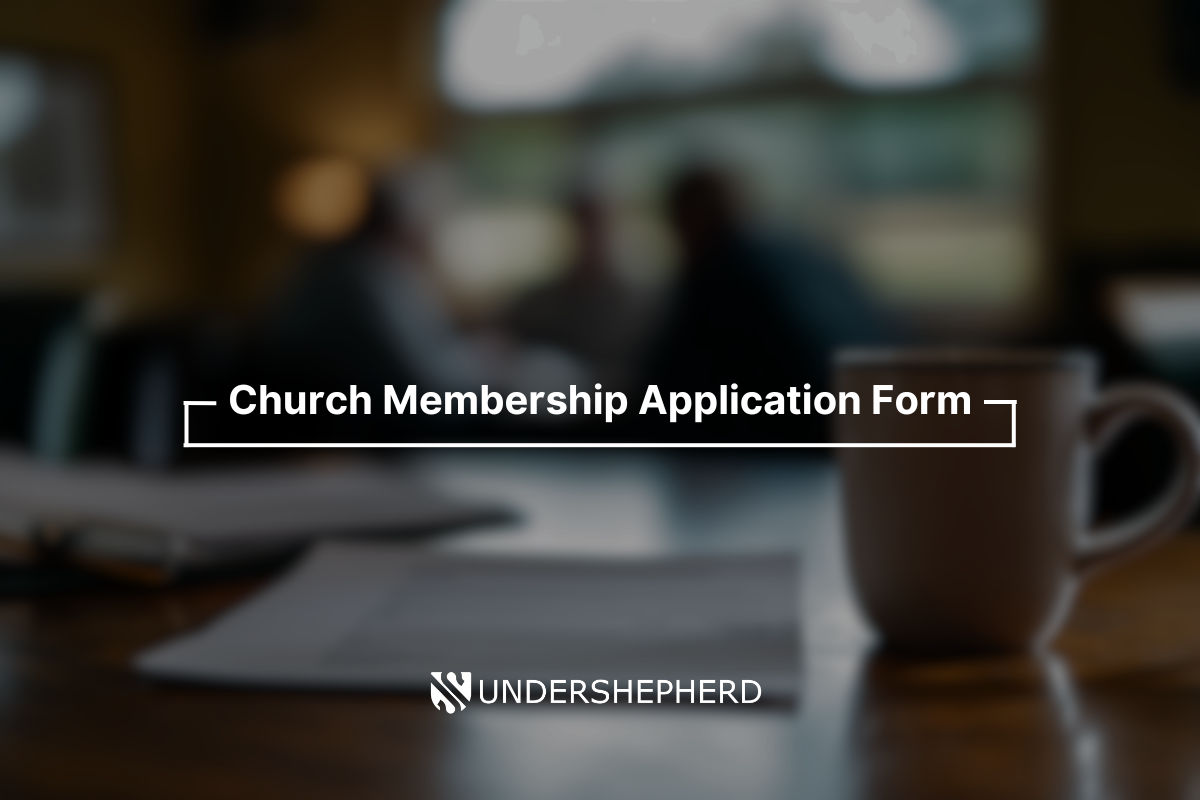Church membership is not merely an administrative formality but a covenant between believers and the local body of Christ. A well-designed church membership application form serves as the gateway to this covenant relationship, establishing clear expectations and fostering spiritual accountability from the very beginning.
The Biblical Foundation for Church Membership
Before delving into the practical aspects of a church membership template, it’s essential to understand the theological underpinnings that make formal church membership necessary and beneficial.
The New Testament presents a clear picture of believers being added to the church: “So those who received his word were baptized, and there were added that day about three thousand souls” (Acts 2:41, ESV) and “the Lord added to their number day by day those who were being saved” (Acts 2:47, ESV). Scripture shows local congregations maintaining recognizable membership (Acts 6:3-6; 1 Corinthians 5:12-13). The metaphor of the church as a body (1 Corinthians 12:12-27) implies a defined, interconnected group rather than a loose association of individuals.
Church membership is a visible expression of our invisible union with Christ and His body. It’s through this formal commitment that believers subject themselves to the authority of elders—”Obey your leaders and submit to them, for they are keeping watch over your souls, as those who will have to give an account” (Hebrews 13:17, ESV)—practice the “one anothers” of Scripture, and participate in the means of grace within the context of covenant community. For more information on Church Membership, see this article by 9marks on Twelve Reasons Why Church Membership Matters.
Essential Elements of a Church Membership Application
A comprehensive church membership process should capture more than just contact information. It should serve as a tool for spiritual assessment, doctrinal alignment, and covenant commitment. Here are the key components:
1. Personal Information
While basic, this section establishes the practical foundation for pastoral care:
- Full name, address, phone number, email
- Date of birth
- Marital status and family information
- Emergency contacts
- Occupation and skills/gifts that could serve the church
2. Spiritual Background & Testimony
Understanding a potential member’s journey of faith helps church leaders better shepherd them:
- Testimony of conversion (with space for a detailed narrative)
- Date and circumstances of baptism
- Previous church affiliations
- Reasons for leaving previous church (if applicable)
- Reasons for seeking membership at your church
3. Doctrinal Affirmation
Doctrinal alignment is crucial for church unity, as Paul writes: “I appeal to you, brothers, by the name of our Lord Jesus Christ, that all of you agree, and that there be no divisions among you, but that you be united in the same mind and the same judgment” (1 Corinthians 1:10, ESV):
- Affirmation of the church’s statement of faith
- Understanding of key biblical doctrines (e.g., salvation by grace alone through faith alone in Christ alone)
- Areas of theological disagreement or questions (if any)
4. Covenant Commitments
This section outlines the mutual responsibilities of church membership:
- Regular attendance at worship services, “not neglecting to meet together, as is the habit of some” (Hebrews 10:25, ESV)
- Participation in a small group or Sunday School (if applicable)
- Financial stewardship through tithes and offerings, giving “cheerfully” (2 Corinthians 9:7, ESV)
- Use of gifts to serve the body, “as each has received a gift, use it to serve one another” (1 Peter 4:10, ESV)
- Submission to church discipline if necessary
- Commitment to pursue holiness and spiritual growth
5. Leadership Endorsement
Space for church elders or pastors to approve the application:
- Interview notes
- Affirmation of the applicant’s profession of faith
- Recommendations for spiritual growth
- Official approval signatures
Creating an Effective Church Membership Template
When designing your church membership application template, consider these important principles:
Balance Thoroughness with Accessibility
While comprehensive information is valuable, an overly lengthy form may intimidate potential members. Strike a balance by:
- Using clear, concise language
- Breaking the form into logical sections
- Providing guidance on how to complete narrative portions
- Offering assistance to those who struggle with written communication
Emphasize Discipleship Over Administration
Frame the application process as a discipleship opportunity rather than a bureaucratic hurdle:
- Include Scripture references that illuminate the importance of church membership
- Provide explanations for why certain information is being requested
- Design questions that prompt spiritual reflection
- View the form as the beginning of a pastoral relationship, not just data collection
Incorporate Biblical Distinctives
The membership form should reflect your theological commitments:
- Include questions about understanding of covenant theology and God’s faithfulness throughout Scripture
- Assess familiarity with historic confessions and catechisms
- Explore the applicant’s understanding of the ordinary means of grace
- Address the roles of church officers according to biblical polity
The Church Membership Interview
The church membership application form should be complemented by a thorough membership interview. This face-to-face conversation allows elders to:
- Hear Their Testimony: Listen carefully to the applicant’s testimony, looking for evidence of genuine faith, repentance, and understanding of the gospel.
- Assess Their Understanding: Move beyond mere intellectual assent to explore how biblical doctrines shape the applicant’s spiritual life.
- Identify Growth Areas: Discuss spiritual disciplines, areas of struggle, and opportunities for discipleship.
- Explain Church Practices: Clarify expectations regarding worship, sacraments, church discipline, and congregational responsibilities.
- Answer Questions: Provide a safe space for applicants to express concerns or seek clarification about church teachings and practices.
Sample Questions for a Church Membership Interview
When conducting membership interviews, consider including these biblically-grounded questions:
- Could you share how God brought you to saving faith in Christ? What do you understand the gospel to be?
- How would you describe your current relationship with the Lord? What spiritual disciplines are you practicing?
- What do you understand the purpose of the church to be? Why do you believe formal church membership is important?
- What spiritual gifts has God given you? How do you hope to serve in this local body?
- Are there any areas of church doctrine or practice that you find difficult to understand or accept?
- Is there any known unrepentant sin in your life that would hinder your fellowship with this church?
- Do you understand and accept the church’s covenant and bylaws? (where applicable)
Implementing the Church Membership Process
Once you’ve developed your church membership application form, consider these steps for implementation:
1. Membership Class
Offer a comprehensive membership class that walks potential members through:
- The church’s history, mission, and vision
- Core doctrinal commitments
- The meaning and responsibilities of church membership
- An explanation of the application process
- Introduction to church leadership
This class provides context for the application form and prepares candidates to complete it thoughtfully.
2. Application Review
Establish a consistent process for reviewing applications:
- Assign applications to specific elders for initial review
- Schedule interviews promptly after submission
- Document any concerns or follow-up questions
- Pray for discernment throughout the review process, for “if any of you lacks wisdom, let him ask God, who gives generously to all without reproach” (James 1:5, ESV)
3. Elder Affirmation
Create a clear pathway for elder approval:
- Present applications at regular elder meetings
- Require unanimous or majority approval (according to your polity)
- Document the decision and any special considerations
- Communicate decisions to applicants with grace and clarity
4. Public Reception
Make the reception of new members a meaningful congregational event:
- Present new members during a member’s meeting
- Have them affirm their membership vows publicly
- Pray over them as a congregation
- Welcome them into fellowship
- Record their membership in church records
Digital vs. Paper Church Membership Forms
In today’s technological age, churches must decide whether to use digital or paper membership applications. Consider these factors:
Benefits of Digital Forms
- Easier to distribute and collect
- Streamlines data entry into church management systems
- Allows for better tracking of the application process
- Environmentally friendly
- More accessible for younger generations
Benefits of Paper Forms
- More accessible for older members
- Creates a tangible record
- May feel more formal and significant to some
- Doesn’t require technical knowledge
- Works when technical systems fail
Many churches now offer both options, allowing members to choose their preferred format while ensuring all necessary information is captured.
Common Pitfalls to Avoid
When implementing a church membership application process, be careful to avoid these common errors:
- Making membership too easy: While we shouldn’t create unnecessary barriers, membership should require commitment and thoughtful consideration.
- Making membership too difficult: Overly burdensome processes may discourage genuine believers from joining.
- Neglecting follow-up: Don’t leave applicants wondering about their status or next steps.
- Emphasizing knowledge over true repentance and faith: While doctrinal understanding is important, evidence of spiritual fruit is equally essential, for “by their fruits you will know them” (Matthew 7:20, ESV).
- Treating membership as merely administrative: Remember that the process is about covenant relationship, not just organizational accounting.
- Failing to shepherd applicants through the process: Provide guidance, answer questions, and offer encouragement throughout.
Storing and Managing Membership Information
Once members have completed your church membership application form, proper record-keeping becomes essential. Historically, churches have maintained physical member rolls, but today’s church management solutions offer more robust options.
Store the member’s completed church membership application form in a tool such as Undershepherd! With Undershepherd you also get the added benefit of a pastoral care tool as well to track conversations, get updates of important life events, and more!
Undershepherd doesn’t just store membership data; it transforms it into a platform for ongoing pastoral care. This tool allows church leaders to:
- Access member information quickly when pastoral needs arise
- Document pastoral visits, counseling sessions, and significant life events
- Set reminders for follow-up with members facing challenges
- Identify patterns that may require additional shepherding attention
- Ensure no member “falls through the cracks” of pastoral care
By connecting your membership process to a comprehensive pastoral care system like Undershepherd, you fulfill the biblical vision of the church as a covenant community where members are known, loved, and shepherded toward Christlikeness.
Membership as Covenant, Not Contract
As we consider the importance of a well-designed church membership application form, let us remember that we are not creating mere contractual relationships but facilitating covenant bonds between Christ’s sheep and their under-shepherds.
The biblical tradition has always emphasized that church membership is not about privileges to be claimed but about responsibilities to be embraced. As Paul writes, “Now you are the body of Christ and individually members of it” (1 Corinthians 12:27, ESV). A thoughtful membership process establishes this God-ordained relationship on the right foundation, setting the stage for faithful discipleship within the covenant community.
When we handle church membership applications with theological care and pastoral sensitivity, we demonstrate our commitment to building churches that reflect the glorious vision of Ephesians 4—communities where members are “equipped for the work of ministry, for building up the body of Christ” (Ephesians 4:12, ESV), united in truth and love, and growing together into the fullness of Christ.


